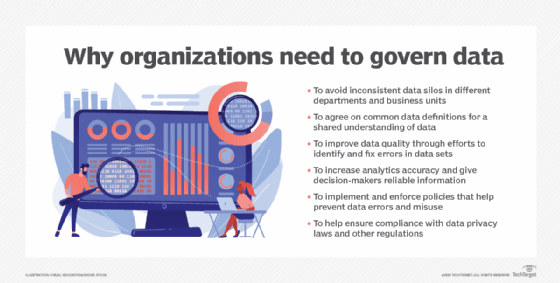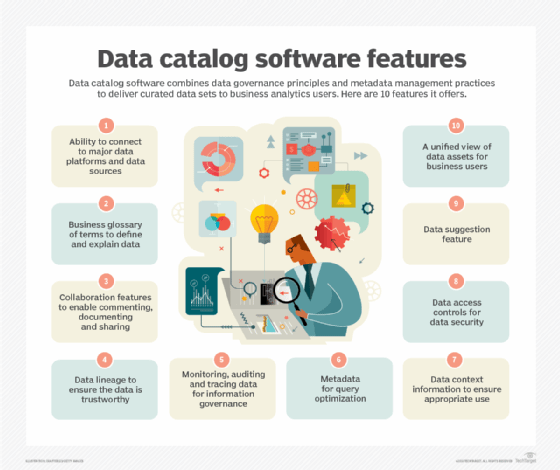What is data democratization?
Data democratization makes information in a digital format accessible to the average end user. The goal of data democratization is to enable nonspecialists to gather and analyze data without requiring outside help.
This is an important step in the modern enterprise, as it increases accuracy and efficiency in the use of data assets, encourages the in-house development of analytics skills and resources, and reduces errors in reporting that can diminish decision support.
What is the primary purpose of data democratization?
Data democratization serves many purposes and offers many benefits, but the greatest is that it breaks down silos that exist with corporate data assets. When individual departments in an organization each have their own data assets, there's often costly duplication of effort, proliferation of error, inaccuracies in reporting between departments and an overall lack of confidence in data integrity.
When data is de-siloed in the enterprise, it gets every department on the same page, minimizing these issues and reducing error and misunderstanding.
What are the pros and cons of data democratization?
Data democratization offers the following benefits:
- Provides a single source of truth. When every department is getting a specific kind of data from a single source -- customer profile data, for instance – there's no doubt or lack of confidence in its integrity.
- Offers faster and easier access to data for business users. When business users must track down data they need and have no resources to help them, the process can be time-consuming and frustrating. Data catalogs and other governance tools make it easier and faster to track down needed data.
- Makes more data available for decision support. When enterprise data assets are well organized and staged for use in analytics and visualization-based reporting, they become more useful and impactful to decision-makers.
- Helps analytics flourish. When data assets are democratized and replatformed for greater accuracy, it enables more business users in the enterprise to begin exploring analytics as a means of improving operations.
Data democratization also includes the following drawbacks:
- Implementation can be challenging. Integrating many sources of data across the enterprise can be daunting and possibly take several years. Data democratization projects also require deep investment from many departments in the organization, adding to the challenge.
- It can be expensive. Cloud migration, data virtualization and federation systems, and data governance tools can be expensive, and there can be a tremendous time and resource cost involved in getting them in place. Typically, outside consultants are required, adding to the cost.
- It changes corporate culture. Data democratization benefits everyone in the enterprise in the long run, but getting everyone on the same page can take a great deal of time. In addition, resistance can and should be expected. Data democratization is transformative, causing many in-house processes to change, often affecting customer and business partner relationships, and that change can be intimidating to many.

How to get started with data democratization
When ownership of data is distributed among independent business functions, a sea change in corporate culture can be required before data democratization can become a reality. In some companies, managers might limit employee access to data because they're afraid that nontechnical employees don't have the necessary skills to interpret data and apply it correctly. In such a corporate culture, internal data governance policies can be established to only grant access to executives, data scientists and IT staff.
Even when an organization wants to embrace democratization, however, there can be impediments to making data freely available. Data might be stored in silos, making it difficult for employees in different departments to access and view it in a consistent manner. Another problem that prevents the average end user from taking advantage of an organization's data is that even small data sets can have inconsistencies that must be cleaned up and files that need to be transformed from one format to another before the data can be used.
An organization can take the following steps to implement a data democratization program:
- Define the program objectives. What does the organization hope to gain from democratization? What problems does it solve? Where are data assets and business objectives out of alignment, and what does good alignment look like? Where does management seek to improve?
- Assess the organization's data assets. It should conduct a full, detailed survey of enterprise data assets from the biggest databases to rogue Excel spreadsheets hiding out in file servers.
- Create data flows for all critical processes. How does data flow through the organization? How should it flow, ideally? The fullest-possible mapping of the movement of data through the company rapidly uncovers bottlenecks, existing and potential issues, and strong existing delivery that needs to be preserved. The end of this process is an ideal set of data flows that represent the future, a roadmap to data democratization.
- Establish standards. Governance must be in place, and all departments must align with it. This often means appointing a data governance officer to communicate and enforce data management standards.
- Begin organizational data transformation. Start putting new data management systems in place, upgrading data storage environments and building new ones, and reengineering the mechanisms that move data between systems.
- Train and empower employees. Successful implementation of data democratization requires employees to have the right level of data literacy to access and use the data effectively. Look to data leaders to drive adoption, and make data literacy part of the new hiring process. Train employees on how data democratization can improve their work outcomes and customer experience.
What tools can be used for data democratization?
Numerous tools are available to aid organizations in implementing data democratization. These include the following:
- Data virtualization software. Data virtualization is the process of accessing enterprise data assets through a virtual interface so that the end user doesn't need to be concerned with its physical location. Examples of data virtualization software products include ConnX, Denodo, IBM Cloud Pak for Data, Informatica PowerCenter and Tibco.
- Data federation software. Similar in principle to data virtualization, data federation unifies all an organization's databases into a single virtual database. Examples of data federation software vendors include SAP, Starburst and Tibco.
- Data visualization and analytics tools. Data visualization tools make data more accessible to end users by configuring it for graphics-friendly, analysis-friendly use in reporting and analytics tools, like Microsoft Power BI and Tableau.
- Data catalogs and other governance tools. Data catalogs make enterprise data assets more accessible and understandable to end users by organizing their metadata in business-friendly configurations and creating a single go-to resource for tracking down data that's needed. Vendors of data catalogs and other tools for data governance include Collibra, Denodo and Informatica.
- Cloud-based data storage. Storing data in the cloud is the best foundational step for moving to data democratization, making better-organized data management systems possible. Several vendors, including AWS, Google, IBM and Microsoft, offer cloud resources.

Advances in virtualization are making data democratization much easier at the technical level and negating the need for ad hoc, highly labor-intensive processes. Data virtualization software, for example, enables an application to retrieve and manipulate data without requiring technical details about the data, such as how it's formatted or where it's physically located.
Data federation software also facilitates democratization by aggregating data from disparate sources in a virtual database so it can be used for business intelligence (BI) or other analysis. The virtual database created by data federation software doesn't contain the data itself. Instead, it simply contains metadata about the data and its location.
Cloud storage has proved especially effective for breaking down data silos by creating a central location for data to be stored. Database management system security features can mask or encrypt data to lower the risks associated with data democratization, and self-service BI applications can provide nontechnical end users with data visualization tools that make data analysis easier to understand. For example, online survey tools with data visualization and reporting capabilities can help marketing teams gather and analyze consumer data and share actionable insights in real time.
As online tools make data democratization easier to achieve, proponents of the concept believe it will narrow the playing field between big brands and smaller businesses. This is expected to create new business models, open doors to new business opportunities and transform the way businesses make data-driven decisions.
Learn how top data management trends, including generative AI, data governance and data lakehouses, can help maximize an organization's data value.
